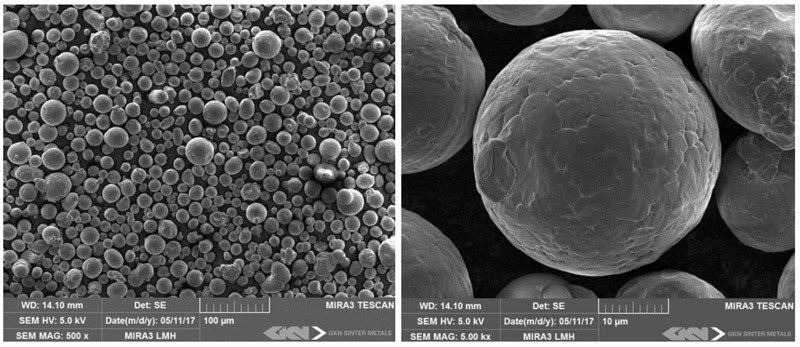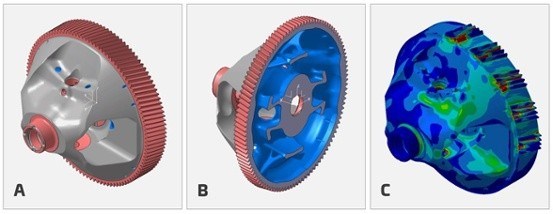GKN and Porsche Develop AM Transmission Part Using New Metal Powder
Using a combination of metal powder-bed fusion and metal powder 20MnCr5, GKN Powder Metallurgy and Porsche 3D-printed an intricate differential housing with gear ring unit on a front traverse transmission.
Share
Read Next
Today’s automotive manufacturers are faced with the ever-increasing demand of improving vehicle efficiency. Manufacturers have tackled the problem from all angles: reducing weight, creating more efficient internal combustion engines, improving powertrains, and reducing noise. But to achieve a more efficient vehicle, the automotive market has started using metal additive manufacturing (AM)
Metal AM enables the development of innovative solutions and shortens time-to-market duration. AM is used for prototyping parts and to mass manufacture parts that require a unique shape, typically impossible to achieve via traditional machining. For automotive, the development of more efficient powertrains, combined with AM design freedom, enables the creation of functional-integrated and weight-reduced AM steel grades that still withstand high wear and loads.
GKN Powder Metallurgy has developed a powder material designed to fit the requirements of the automotive industry: 20MnCr5. This steel grade powder is said to offer ductility without compromising strength, wear resistance through case hardening, high fatigue strength and toughness that doesn’t detract from machinability. This material can form a medium-strength steel grade able to be case-hardened and which has high wear resistance, mechanical strength and performance-to-cost ratio, the company says. Furthermore, initial test results indicate that 20MnCr5 can meet current 16MnCr5 medium steel quality levels.
To validate these results, GKN and Porsche used 20MnCr5 to 3D print a conventional front transverse transmission. They chose to design the transmission part with the largest weight reduction potential: the differential housing with ring gear unit. Ultimately, they created a more efficient transmission part that could not have been produced without AM.
Using CAD and topology structural optimization software, GKN and Prosche designed a new shape for the differential housing with ring gear unit. They first defined the maximum available space within the transmission and subtracted the inner contours needed by any function (bevel gears, side shafts, bearings, etc.) from the body of the part (see Figure 4).
Based on the specifications and requirements of the transmission, all loads (bearing and gear) were applied to the package block. The CAD optimization tool delivered a structure capable of taking all required loads. The resulting structure (Figure 5) is not producible with conventional tools, but creating the product close to the calculated structure is possible with AM. For example, the inner shape of the differential housing part is supported by a system of organic beams and structures that are necessary for its structural integrity. While these shapes cannot be machined with traditional methods, AM enabled the part to be printed from scratch. The AM process does require that the part be designed with special features such as holes to eject the unused metal powder or openings on the outer diameter to drain collected oil, but these features can be designed into the model from the beginning.
The final finite element analysis showed a very homogeneous stress level. This enabled a reduction in wall thickness, a characteristic not previously possible. Based on the original load requirements, the calculation achieved a 13 percent weight reduction, a 43 percent reduction of tooth stiffness variations in radial direction, a 69 percent reduction of tooth stiffness variations in tangential direction and an 8 percent reduction of inertia.
The use of AM with special metals like 20MnCr5 introduces a future of metal additive production that yields parts that are weight efficient and structurally strong.
Adapted from an article that originally appeared on GKN’s blog.
Related Content
A Tour of The Stratasys Direct Manufacturing Facility
The company's Belton manufacturing site in Texas is growing to support its various 3D printing applications for mass production in industries such as automotive and aerospace.
Read MoreHow AM Enables Cobot Automation for Thyssenkrupp Bilstein (Includes Video)
The shock absorber maker has responded to its staffing shortages through extensive use of collaborative robots. In-house 3D printing makes this possible by providing the related hardware needed to complete the cobot-automated cells.
Read MoreMultimaterial 3D Printing Enables Solid State Batteries
By combining different 3D printing processes and materials in a single layer, Sakuu’s Kavian platform can produce batteries for electric vehicles and other applications with twice the energy density and greater safety than traditional lithium-ion solutions.
Read MoreAutonomous Cobot Automation Increases Production 3D Printer Output for Ford (Includes Video)
A mobile robot that travels to each Carbon machine to unload builds lets the automaker run an additional three to four builds per machine per day. Autonomous robots fit well with 3D printing, but their role in production will extend beyond just the additive machines.
Read MoreRead Next
At General Atomics, Do Unmanned Aerial Systems Reveal the Future of Aircraft Manufacturing?
The maker of the Predator and SkyGuardian remote aircraft can implement additive manufacturing more rapidly and widely than the makers of other types of planes. The role of 3D printing in current and future UAS components hints at how far AM can go to save cost and time in aircraft production and design.
Read More3D Printing Brings Sustainability, Accessibility to Glass Manufacturing
Australian startup Maple Glass Printing has developed a process for extruding glass into artwork, lab implements and architectural elements. Along the way, the company has also found more efficient ways of recycling this material.
Read More4 Ways the Education and Training Challenge Is Different for Additive Manufacturing
The advance of additive manufacturing means we need more professionals educated in AM technology.
Read More

























